Farmers Tell USDA to Expect Record Soybean Yields But Corn Yields Are Lower Than Trend
TOPICS
USDA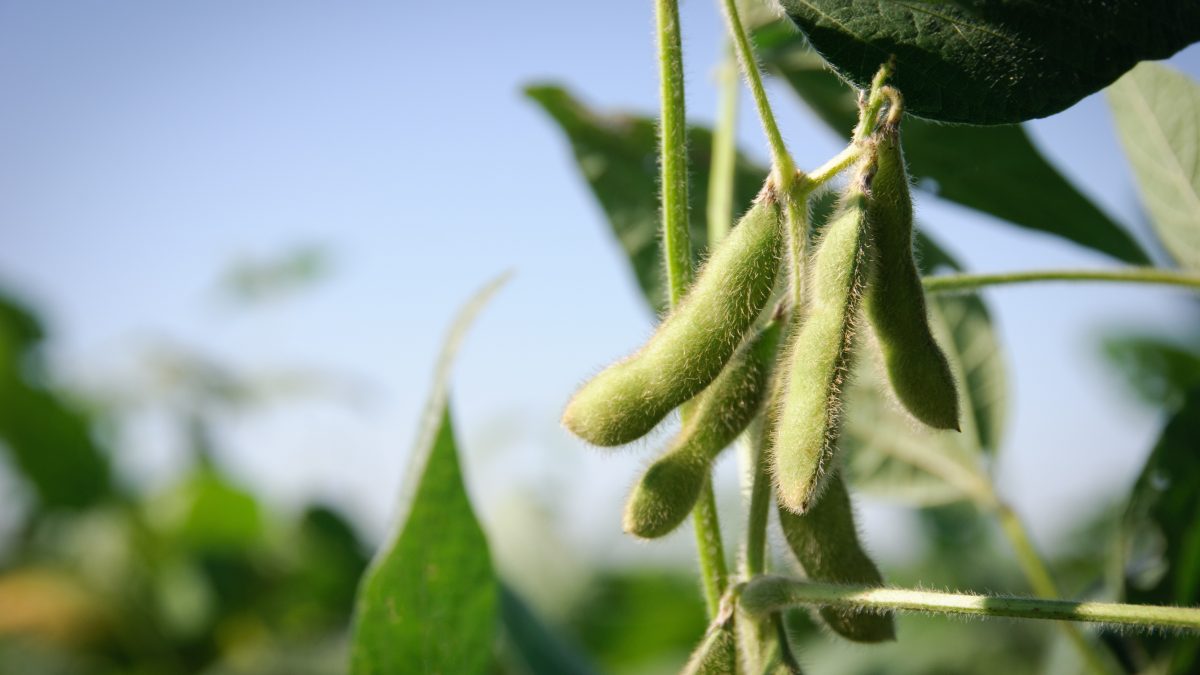
photo credit: Getty
Shelby Myers
Former AFBF Economist
USDA released its August Crop Production report on Aug. 12 and the survey-based report has farmers indicating corn yields will reach 175.4 bushels per acre and soybean yields at a record 51.9 bushels per acre in 2022. This is despite extreme heat and sporadic rainfall throughout the countryside. The report provides the most recent update for U.S. commodity supplies since the June 30 Planted Acreage report, providing the next comprehensive look at overall production for the 2022 crop year.
The soybean yield reported, 51.9 bushels per acre, is up 0.5 bushels per acre, or 1%, compared to 2021 and is a slight increase from USDA’s previous trend yield estimates of 51.5 bushels per acre as reported in the July USDA World Agricultural Supply and Demand Estimates report. For corn yields, the USDA report indicates that yields will rise to 175.4 bushels per acre, which is 1.6 bushels per acre lower (1%) compared to 2021 yields of 177 bushels per acre, the fourth-highest corn yield on record, and where USDA has pegged the corn trend yield to be since May. Prior to the report’s release, the average trade estimate for U.S. soybeans was 51.1 bushels per acre, with a range of 49.9 bushels per acre to 52.5 bushels per acre. Trade analysts’ estimates for corn yields prior to the report’s release averaged 175.9 bushels per acre with a range of 171.5 to 180.3 bushels per acre. It’s important to note that the crop production data from this report is based primarily on farmer surveys and satellite imagery. Field samples from USDA’s objective yield survey plots will not be available and incorporated into reports until September.
2022 Record Soybean Yield
Illinois leads the country in estimated soybean yield with 66 bushels per acre, an increase of 3% compared to 2021 when soybean yield was 64 bushels per acre. Indiana follows just behind with an estimated soybean yield of 60 bushels per acre, up 1% from 2021 when soybean yield was 59.5 bushels per acre. Iowa is third, expecting 58 bushels per acre for soybeans, which is down 6% from 2021 when soybean yield was 62 bushels per acre.
North Dakota leads with the largest year-over-year increase in estimated soybean yield, up 37%, reporting that soybean yields will be 35 bushels per acre, up from 25.5 bushels per acre in 2021. South Dakota shows the second-largest year-over-year increase, up 8%, moving from 40 bushels per acre in 2021 to 43 bushels per acre in 2022. Minnesota is expected to increase soybean yields by 6% compared to 2021, moving from 47 bushels per acre to 50 bushels per acre in 2022. These yield increases are especially significant given these three states in particular faced dire drought conditions throughout 2021, followed by a series of weather delays during planting season in 2022.
The below maps include USDA’s August 2022 soybean yield estimates and the year-over-year change in soybean yield compared to 2021.
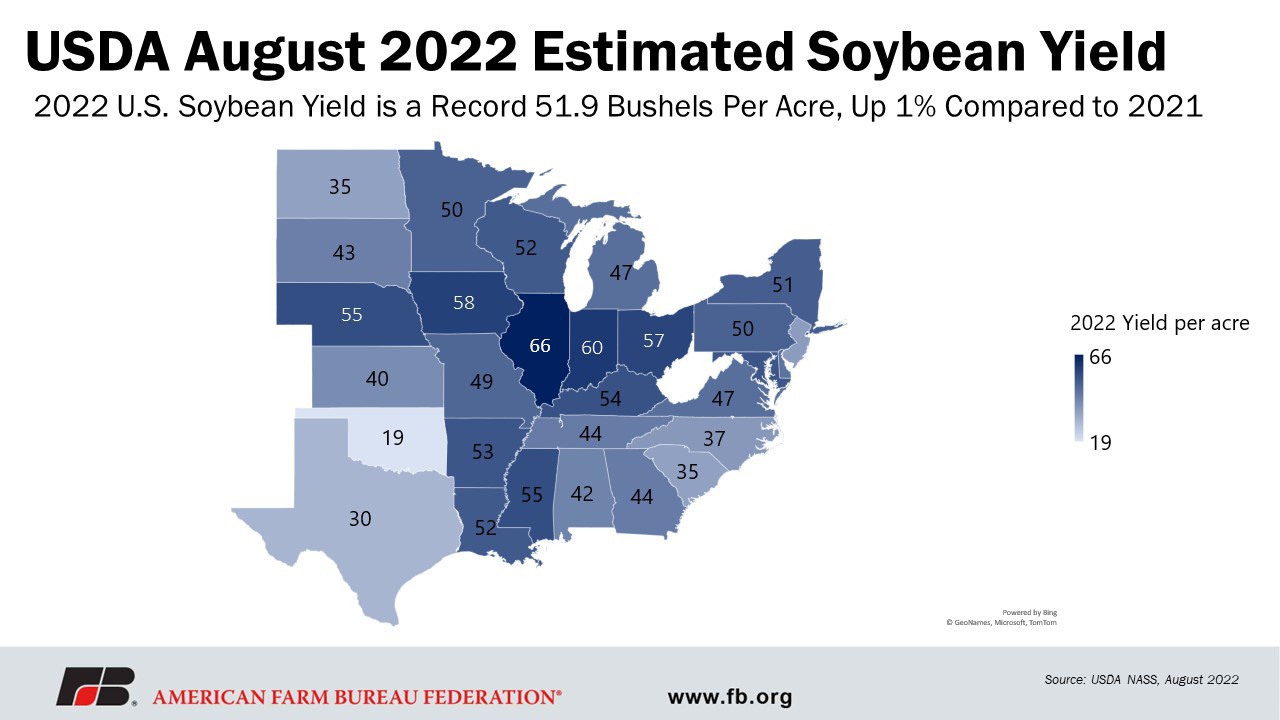
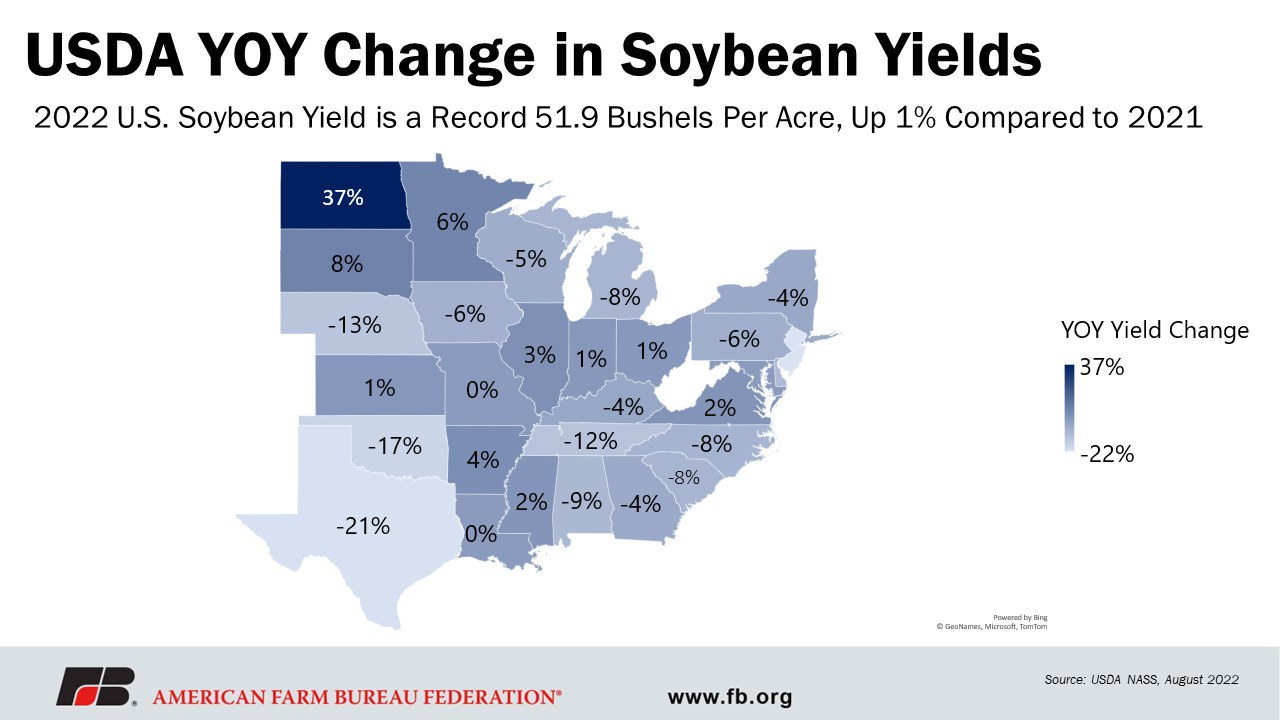
Soybean Supply and Demand Expectations from August WASDE
USDA’s soybean yield estimate of 51.9 bushels per acre increases the supply estimate for the 2022/23 marketing year in the August WASDE, which adjusts soybean production to 4.53 billion bushels, increasing 26 million bushels, or less than 1%, compared to the overall soybean production estimate reported in the July WASDE. Compared to 2021, this yield adjustment and increase in soybean production pushes the 2022 soybean production to 2.2% higher than 2021, making it the largest soybean production year on record if it comes to fruition. USDA lowered soybean planted acres and harvested acres by 300,000 acres to accommodate the resurveyed states. USDA also made adjustments to the 2021/22 marketing year demand expectations that increased stocks by 4.7% or 10 million bushels, that will be carried over to 2022 and increasing supply. The reduced planted soybean acres but additional amount of soybean production and beginning stocks net to add 36 million bushels to the supply-side, which is a 1.4% increase in overall U.S. soybean supply compared to 2021, rising to 4.77 billion bushels from 4.71 billion bushels.
On the soybean demand side for the 2022/23 crop year, USDA increased expectations for soybean exports, up nearly 1% or 20 million bushels, and added 1 million bushels to the residual use. Ending stocks expectations for 2022/23 soybean rose 6.5% compared to July, up 15 million bushels, which pushed the stocks-to-use ratio to 5.3% from 5.1%. USDA estimates the average farm price for soybeans to lower from July’s $14.40 per bushel estimate to $14.35 per bushel in August, about $1.05 per bushel higher than in 2021, and just shy of the record $14.40 per bushel in 2012.
2022 Corn Yield
For non-irrigated corn, the highest yields start in Iowa where farmers put yields at 205 bushels per acre, equivalent to yields in 2021. Illinois also reported a near flat-rate yield estimate compared to 2021, reporting the second-highest yield of 203 bushels per acre, compared to 202 bushels per acre last year. Minnesota is estimated to have the third-highest non-irrigated corn yield with 193 bushels per acre, up 8% from 2021 when Minnesota’s drought-stricken corn yielded 178 bushels per acre. Washington leads irrigated corn yields with an estimated 225 bushels per acre, an increase of 3% compared to 2021. California is just behind with an estimated 220 bushels per acre of corn, up 17% from 2021 when the state yield was 188 bushels per acre.
North Dakota has the largest year-over-year increase in corn yields, up 38% compared to 2021, moving from 105 bushels per acre to 145 bushels per acre. The second-largest percentage increase is California, circuitously reported above with a 17% increase compared to 2021. South Dakota and Minnesota both rebound from drought-stricken corn in 2021, increasing yields in 2022 by 9% and 8% respectively.
The below maps include USDA’s August 2022 corn yield estimates and the year-over-year change in corn yield compared to 2021.
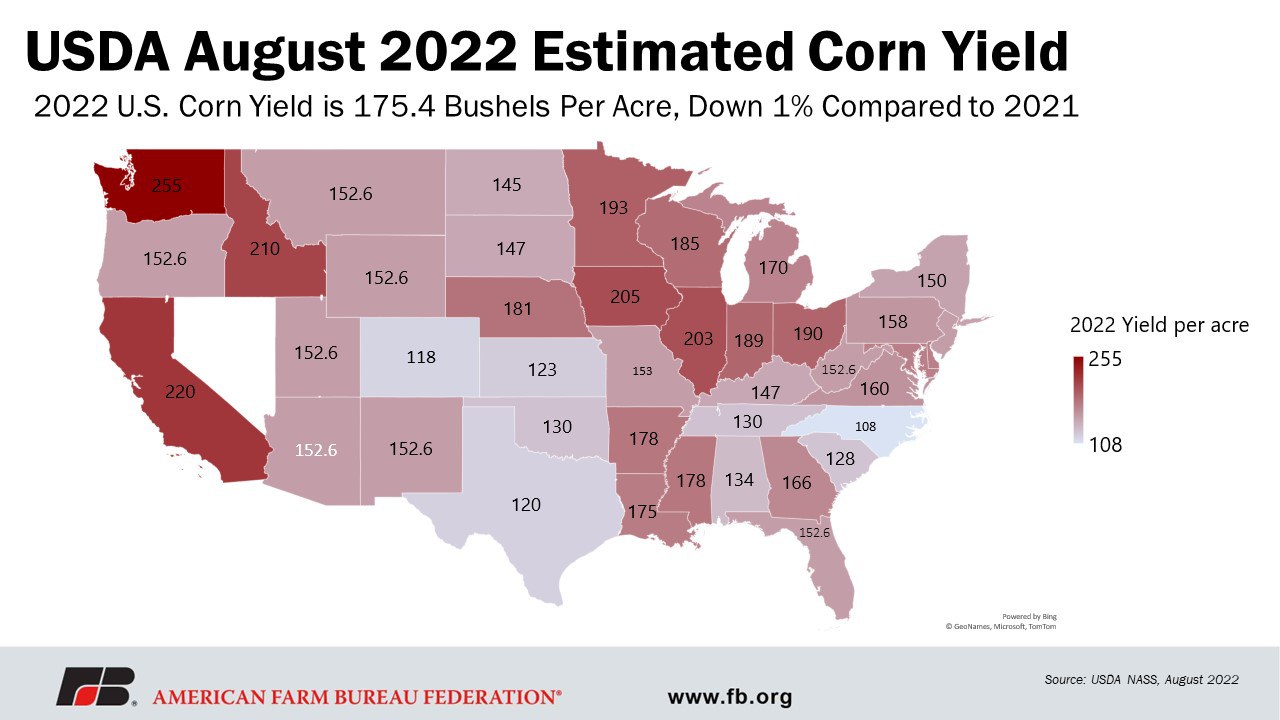
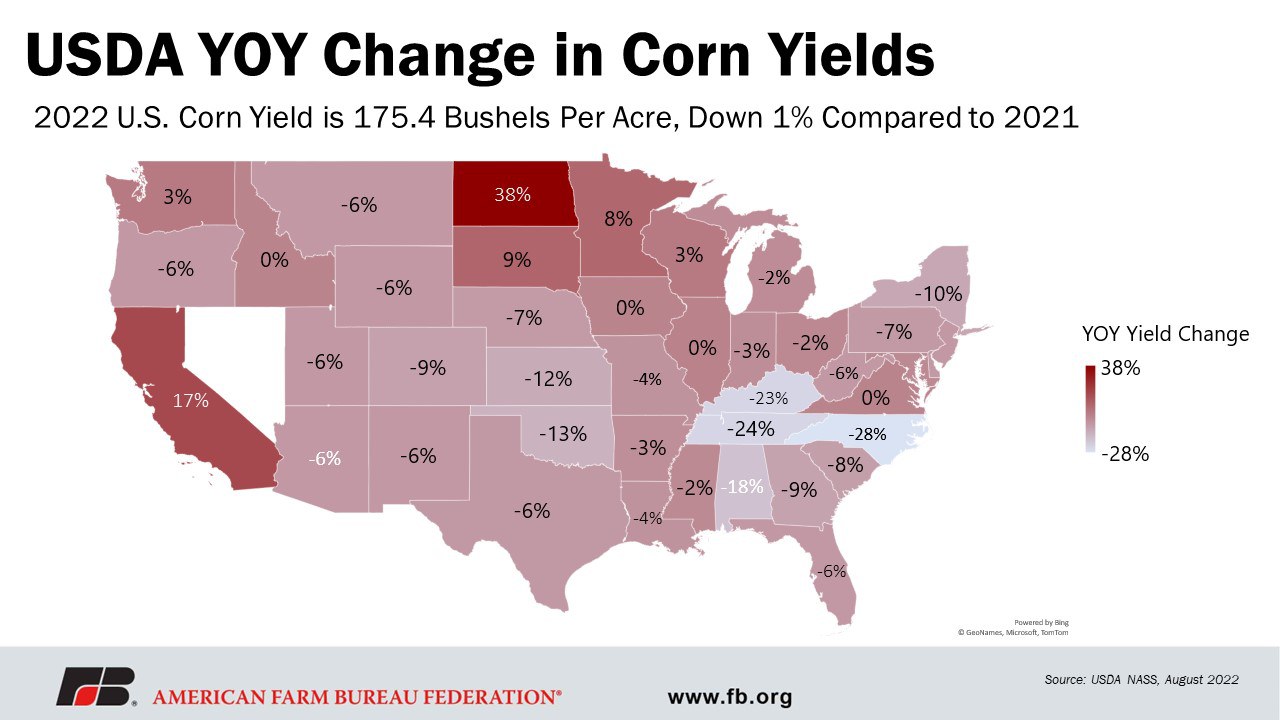
Corn Supply and Demand Expectations from August WASDE
Given the 175.4 bushel per acre estimate for corn yield, USDA lowers production for the 2022/21 marketing year by 146 million bushels in the August WASDE, dropping from 14.5 billion bushels in July to 14.3 billion bushels, which would be a 5% decrease compared to production levels of corn in 2021. USDA reported a reduction in domestic use, primarily for ethanol use, on the 2021/22 corn balance sheet, which increased ending stocks for the marketing year, thus increasing the quantity of corn carry-over into the 2022/23 marketing year by about 20 million bushels. Minor changes to corn planted acres following the results of the three states resurveyed after June decreased planted and harvested corn acres by 100,000 acres. The culmination of these changes led to a supply reduction for the 2022/23 corn marketing year of about 127 million bushels, moving from 16 billion bushels to 15.9 billion bushels. These expectations result in a reduction of supply by 2.8% compared to supply in 2021.
On the demand side for the 2022/23 corn marketing year, USDA adjusted lower feed and residual use by 25 million bushels, but increased food, seed and industrial use of corn by 5 million bushels compared to expectations in July. Exports of corn were also reduced by 25 million bushels. The reductions in major use categories, totaling 45 million bushels, compound reductions in corn production and is not made up in the increased carry-over from 2021/22. Ending stocks for the 2022/23 marketing year lowered 82 million bushels to 1.3 billion bushels, about 9.3% lower compared to 2021 ending stocks. The stocks-to-use ratio for 2022 sits at about 9.6%, lower than the 10.3% reported for 2021. USDA kept the average farm price for corn at $6.65 per bushel in August as it was in July, sitting about $1.42 per bushel higher than in 2021. This is the second-highest historical average, behind $6.89 per bushel in 2012.
June 30 Acreage Update
As previously described, USDA included in the August Crop Production report updates to the June 30 Acreage report following the resurveying of farmers due to planting delays in Minnesota, North Dakota and South Dakota. Farmers in those states had reported specific acreage as “not yet planted” for the June 30 release of the Acreage Report. Corn planted acres for the U.S. decreased from 89.9 million acres to 89.8 million acres after the resurvey, while soybean planted acres decreased from 88.3 million acres to 88 million acres. Minnesota reduced estimated corn planted acres from 8.3 million acres to 8.2 million acres, while North Dakota and South Dakota reported no changes in the resurvey and remain at 3 million acres of corn and 5.9 million acres of corn, respectively. For soybeans, Minnesota reported no changes in the resurvey and remains at 7.5 million acres of soybeans, while North Dakota reduced planted acres from 5.9 million acres in the June report to 5.7 million acres in the August update. South Dakota also reported a slight decrease in planted acres of soybeans, moving from 5.5 million acres in June to 5.4 million acres in the August update.
Summary
In the survey-based August Crop Production Report, USDA reported a record 51.9 bushels per acre for soybeans, up 1% compared to 2021, and a corn yield of 175.4 bushels per acre, down 1% compared to 2021 and lower than USDA trend yields suggested. These survey results reflect the sentiment of the most recent USDA Crop Progress report that moved the rating of good-to-excellent corn from 64% to 58% due to heat stress from high temperatures and dry conditions. The soybean crop continues to fare a little better against the drier conditions. On the demand side, grain marketers will continue to monitor global supplies of commodities, particularly for Europe, Russia and Ukraine, especially in light of the big surprise in this month’s WASDE that increased Russia’s wheat crop from 81.5 million metric tons to 88 million metric tons. These U.S. yield estimates will be updated in the September report, which will include the objective yield plots as part of the production estimates for the first time this year to confirm or amend what farmers have begun to see in their fields.
Top Issues
VIEW ALL